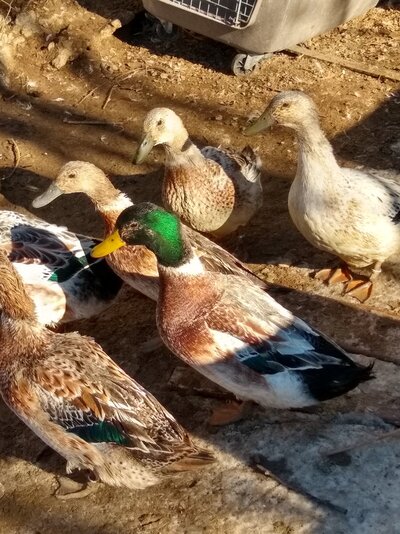I wanted to double check this. I read some of the other posts on winter egg production but there's holes in the follow up.
Earlier threads don't state whether or not using a light/red light/heat lamp etc in winter for egg production needs to be on during both day and night, or only during the night. There's also no follow up of people coming back and saying whether or not their experiments worked or not. Its assumed it worked, but nobody comes back and says, hey I tested it, here was the result....
Does this also explain why some people are quoting ducks and chickens for 2 different egg production ratios? I'd literally seen people quoting welsh harlequinn ducks for up to 300 eggs per year, and others quoting for just under 200 eggs per year. Maybe whether or not they had a warming light is the difference? And I'd seen this for runners and others being quoted 2 vastly different figures also.
After you start a warming light for the birds in winter, how long will it take for it to have an effect and turn production back on? (And does this need to be on during day also, or only night?) And another issue is that my ducks go out of the pen and literally won't go back in the pen during the day. So this makes me wonder how you would work this out to get egg production going again? Will the warming lights work to get egg production going again for BOTH ducks and chickens? (Especially if ducks like to go play in the cold...?)
*The reason why I brought this up again is that my ducks have already not been laying for about 3 months now. I can't afford to not have them lay any longer. And its clear the economy is in trouble. I want to know how to get this to work because I can see prices double in my areas what they were last year for many consumer goods. Its only a matter of time before things are getting too expensive. The area we live in has become too expensive already to stay in.*
*I am OK with giving my ducks a break from winter laying. But its already 3 months now. That should be long enough. I don't want to have to buy eggs. Local stores have increased egg prices again in my area again. And part of the justification for having the birds was that the eggs would pay for their feed. But if they aren't laying... the feed isn't being paid for.*
What's this thing about red lights about also? Do you they produce more heat? (And without increasing fire risk?) Can you get a cheaper warming light with a red light for a normal light bulb socket? Or do I still have to use the 'fire hazard' exploding chick incubator standard bigger light?
Earlier threads don't state whether or not using a light/red light/heat lamp etc in winter for egg production needs to be on during both day and night, or only during the night. There's also no follow up of people coming back and saying whether or not their experiments worked or not. Its assumed it worked, but nobody comes back and says, hey I tested it, here was the result....
Does this also explain why some people are quoting ducks and chickens for 2 different egg production ratios? I'd literally seen people quoting welsh harlequinn ducks for up to 300 eggs per year, and others quoting for just under 200 eggs per year. Maybe whether or not they had a warming light is the difference? And I'd seen this for runners and others being quoted 2 vastly different figures also.
After you start a warming light for the birds in winter, how long will it take for it to have an effect and turn production back on? (And does this need to be on during day also, or only night?) And another issue is that my ducks go out of the pen and literally won't go back in the pen during the day. So this makes me wonder how you would work this out to get egg production going again? Will the warming lights work to get egg production going again for BOTH ducks and chickens? (Especially if ducks like to go play in the cold...?)
*The reason why I brought this up again is that my ducks have already not been laying for about 3 months now. I can't afford to not have them lay any longer. And its clear the economy is in trouble. I want to know how to get this to work because I can see prices double in my areas what they were last year for many consumer goods. Its only a matter of time before things are getting too expensive. The area we live in has become too expensive already to stay in.*
*I am OK with giving my ducks a break from winter laying. But its already 3 months now. That should be long enough. I don't want to have to buy eggs. Local stores have increased egg prices again in my area again. And part of the justification for having the birds was that the eggs would pay for their feed. But if they aren't laying... the feed isn't being paid for.*
What's this thing about red lights about also? Do you they produce more heat? (And without increasing fire risk?) Can you get a cheaper warming light with a red light for a normal light bulb socket? Or do I still have to use the 'fire hazard' exploding chick incubator standard bigger light?





